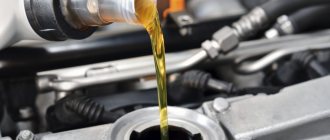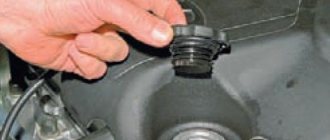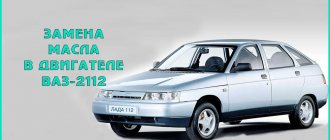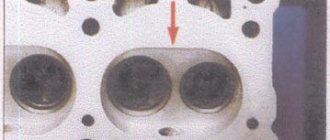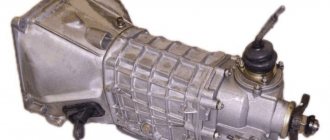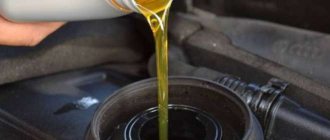Cars admin26.02.2020
| Year | Viscosity SAE |
| all season from +25 to -25 °C | winter from -35 to 0 °C | summer from 0 to +35 °C |
To purchase a suitable oil, you will need to name the SAE viscosity index
and acceptable -
API oil quality
for a diesel or gasoline engine. (Manufacturer's choice at your discretion).
For example:
for a VAZ 4x4 gasoline engine (Body 21214) 2009, all-season semi-synthetic oil 10W-40 with SL quality is suitable, and for models of 2014, for the cold season, synthetic 0W-40 SM is suitable.
If possible, check the oil you select to ensure it meets your vehicle manufacturer's specifications and service intervals.
Reg.: 10.10.2012 Threads / Messages: 17 / 2751 From: Moscow Age: 55 Car: 213100M 2011 E-gas
AvtoVAZ recommends undergoing maintenance (MOT) of the Niva (VAZ 2121 and VAZ 2131) every 12 months or 10,000 km, whichever comes first.
Engine oil Original LADA engine oil: 88888L05400100 — ULTRA 5W-40, 1 l (synthetic technologies) 88888L05400400 — ULTRA 5W-40, 4 l (synthetic technologies) 88888L15400100 — PROFESSIONAL 5W-40, 1 l (semi-synthetic) 88888L 15400400 – PROFESSIONAL 5W-40.4l (semi-synthetic) ROSNEFT Premium or ROSNEFT Maximum 5W-40 or 10W-40. Or Lukoil Genesis RN 5W-40
Transmission oil "NOVOIL T" (80W-90; GL-5); "OMSCOIL SUPER T" (85W-90; GL-5); "REXOL T HYPOID" (80W-90, 85W-90; GL-5); "VELS TRANS" (85W-90; GL-5); "VELSTM" (80W-90, 85W-90; GL-5); "UFALYUB UNITRANS" (85W-90; GL-5); "NORSI" (80W-90, 85W-90; GL-5); “LUKOIL TM-5 or VOLNEZT-1” (85W-90; GL-5); "LUKOIL TM-5" (80W-90.85W-90; GL-5); "ANGROL T" (80W-90, 85W-90; GL-5); "SPECTROL FORWARD" (80W-90; GL-5); "SPECTROL CRUISE" (85W-90; GL-5); "SAMOIL 4402" (85W-90; type GL-5); "SAMOIL 4404" (85W-90; GL-5); "SAMOIL 4405" (85W-90; GL-5); “YAR-MARKA SUPER T” (80W-90, 85W-90; GL-5); "AGIP ROTRA MP" (80W-90; GL-5); "AGIP ROTRA MP DB" (85W-90; GL-5); "MP GEAR LUBE-LS" (80W-90, 85W-140; GL-5).
Coolant LADA G-11 - 88888400001082 and 88888400005082 LADA G-12 - 88888200001082 and 88888100005082 (red) Antifreeze G-48; Cool Steam Standard; Cool Steam Premium; TS-Felix; Felix Carbox; SINTEC (for example, “Antifreeze SINTEC” TU 2422-047-51140047-2007); Long Life; G-Energy Antefreexe.
Hydraulic brake and clutch system Original Lada TJ: DOT-4 - 88888100000582 and 88888100001082
Power steering Pentosin Hydraulik Fluid CHF 11S-TL VW52137 Source https://lada.online/do-my-self/r...tikuly-i-zapravochnye-obemy.html
Reg.: 09.10.2013 Threads / Messages: 19 / 534 From: Russia, Moscow-Tula Age: 31 Car: Niva 21214m, 2013; Niva 21214, 2009 (frame, warriors, RK-69.)
and then we leave the engine under the car somewhere along the road and scratch our heads, saying, “How can this be, I bought a whole liter and filled it up according to the official
AvtoVAZ recommendations!” We’ll skip the transmission for now, we’ll come back to it in a couple of lines.
"cool steam"? This is something new. Personally, I would be afraid to put something “vaporous” into the cooling system. Again, I'm being sarcastic. yes, there is a very good coolant “CoolSt r”
eam" (obviously, this is what she meant). That’s exactly what I settled on, after studying a bunch of articles and reviews, spending a lot of time on it. and I also spent a lot of time searching and acquiring it.
next is brake fluid
similar to brake fluid, one line here and there.
Let's go back to the transmission. here we see a whole list compiled for the new letters on the left side - those in quotes. and what’s in the parentheses—in fact, almost every line repeats oh yes, only in one of them we suddenly see “85W-140,” well, that’s okay.
What to pay attention to
When deciding what kind of oil to pour into the Niva engine and car transmission, it is first of all worth noting that it is much easier to replace the lubricant in the gearbox. However, even in this case, the driver must remember several important nuances. For example, the car owner must ensure proper lubrication of all gears of a given unit. The composition should form a thin film on the parts that will protect them from premature wear and scuffing. Thus, depending on what kind of oil is poured into the Niva’s gearbox, you can expect how soon expensive repairs to your favorite car may be required.
Field oil, transmission
Here the situation is both simpler and more complicated. It’s simpler because if you fill the gearbox with oil or oil with a different tolerance, the consequences will not be as terrible as in the engine. The most common mistake in Zhiguli cars is filling the axles and gearboxes with the same oil with index GL5. This approval indicates that the oil is intended to work with hypoid gears, which include the Niva gearbox. But under no circumstances should it be poured into the checkpoint. Or rather, to put it another way, it is possible “but not for long.” The sulfur-phosphorus additive contained in this oil “eats” the copper synchronizers, and gearbox glitches begin (gears fly out, engage with a grinding noise). And the person is sincerely surprised that he was recently filled with expensive oil, which is poured into the mechanical boxes of Mercs and Toyotas, but it only got worse. Moreover, not much time passes from filling the oil to the first “attacks”. Sometimes less than 5 thousand km. Therefore, my recommendation, based on experience, is: gearbox and transfer case oil 80-90 GL5, gearbox 80-90GL4. Just remember that in winters like now, when the temperature reaches -25..-30, it is advisable to start using this oil in a “low gear” and turn it off after 500 meters, when the oil in the gearboxes and transfer case “warms up” a little. Or a more expensive option, oil 75-80 GL4+, with a combined tolerance, which can be poured anywhere.
Main indicator of liquid
The most important characteristic that you need to pay attention to when choosing a lubricant is its viscosity. If we are talking about oil, the composition must meet the requirements of international quality standards SAE J306. This type of certification was developed in the USA and is generally accepted today. Therefore, first of all, you need to make sure that the selected oil is accompanied by all the necessary documentation or that all the necessary information is indicated on the packaging.
When deciding which oil to pour into Niva axles and other components, you need to evaluate the viscosity of the composition. According to the standards, the letter “W” corresponds to this indicator. As a rule, such a symbol is indicated on seasonal compositions. If there is a letter “W” on the package, this indicates that the liquid can be used in winter. In the absence of this symbol, oil may only be used in positive ambient temperatures.
Based on this, many believe that seasonal lubricants are much better. However, this is not quite true. The fact is that when operating any car, you need to change the oil even before it has exhausted its service life. Therefore, you should not be happy if the composition does not change its characteristics throughout the year.
All-season formulations are also on sale. These are the so-called thickened oils. They have the characteristics of both summer and winter lubricants.
It is equally important to pay attention to the performance properties of oils. In this case there are also certain standards (APIs). Also, when deciding what kind of oil to pour into the Niva, it is worth considering its composition.
Results
In most cases, the Niva is used for off-road driving, which puts a lot of stress on the transmission. Therefore, it is optimal to change the oil after a mileage of 15–20 thousand kilometers. Do not save where it is fraught with bad consequences. When performing vehicle maintenance, evaluate the condition of all engine components, and also change filters and spark plugs at least once every two oil changes.
During the operation of the vehicle, lubricants should be changed on time. High-quality operating fluids with correctly selected properties will extend the service life of components and assemblies, and can also reduce noise during their operation. Let's figure out what gear oil to fill in Lada 4×4 when replacing.
Based on the manual for the operation, maintenance and repair of the VAZ-21213 car and its modifications, we publish the following data. The data is also relevant for modern SUVs VAZ 21214 and 21310.
| Refueling or lubrication point | How much oil, l |
| Gearbox housing | 1.35 (4st)/1.6 (5st) |
| Rear axle housing | 1,3 |
| Steering gear housing | 0,18 |
| Transfer case housing (transfer case) | 0,75/0,79 |
| Front axle housing | 1,15 |
What transmission oil is recommended for Lada 4×4: “ NOVOIL T ” (80W-90; GL-5); " OMSCOIL SUPER T " (85W-90; GL-5); " REXOL T HYPOID " (80W-90, 85W-90; GL-5); " VELS TRANS " (85W-90; GL-5); " VELSTM " (80W-90, 85W-90; GL-5); " UFALYUB UNITRANS " (85W-90; GL-5); " NORSI " (80W-90, 85W-90; GL-5); “ LUKOIL TM-5 or VOLNEZT-1 ” (85W-90; GL-5); " LUKOIL TM-5 " (80W-90.85W-90; GL-5); " ANGROL T " (80W-90, 85W-90; GL-5); " SPECTROL FORWARD " (80W-90; GL-5); " SPECTROL CRUISE " (85W-90; GL-5); " SAMOIL 4402 " (85W-90; type GL-5); " SAMOIL 4404 " (85W-90; GL-5); " SAMOIL 4405 " (85W-90; GL-5); " YAR-MARKA SUPER T " (80W-90, 85W-90; GL-5); " AGIP ROTRA MP " (80W-90; GL-5); " AGIP ROTRA MP DB " (85W-90; GL-5); " MP GEAR LUBE-LS " (80W-90, 85W-140; GL-5).
Read more: Traffic police 71 official Tula
Selecting the viscosity of the transmission oil:
| Minimum temperature to ensure lubrication of components, o C | SAE viscosity grade | Maximum ambient temperature, o C |
| -40 | 75W-80 | 35 |
| -40 | 75W-85 | 35 |
| -40 | 75W-90 | 45 |
| -26 | 80W-85 | 35 |
| -26 | 80W-90 | 45 |
| -12 | 85W-90 | 45 and above |
Recommended application temperature range:
- 80W-90 – from -26 to +40 degrees Celsius.
- 85W-90 – from -12 to +45 degrees Celsius.
The manufacturer fills in with mineral gear oil. Many owners note in their reviews that after replacing mineral oil with semi-synthetic or synthetic oil, gearbox noise decreased and vibrations became less. And in winter, in cold weather, gears began to engage much easier, and after a couple of minutes of warming up, you can safely start driving.
What gear oil do you recommend for Lada 4×4? Leave your comments and take the poll below. Let us remind you that in another article, Lada 4×4 owners determine the best engine oil.
Key words: 4x4 gearbox
Mineral lubricants
Of course, it is logical to assume that the more natural the composition, the better it will be. This fact is confirmed by the unique properties of oils of this type. When using mineral compounds, contacting parts will deteriorate much more slowly. In addition, the so-called natural compounds have excellent anti-corrosion properties.
There are also those car owners who believe that mineral oils are not able to cope with heavy loads. But it is worth considering that during the internal combustion process, many mineral deposits are formed in the engine, which negatively affect the operation of the power unit. Mineral oils may indeed not be able to cope with serious “build-ups” of burnt particles. However, if we are talking about a car with low mileage, then “mineral water” will be quite enough.
Synthetic oils
When deciding what oil to pour into the Niva, many come to the conclusion that artificial compounds have better characteristics. Synthetic formulations may actually be more beneficial. During the development of such oils, complex chemical processes are used, thanks to which the characteristics of the fluid can be adjusted.
If we talk about the advantages of synthetic compounds, it is worth considering that they remain resistant to thermal changes much longer and retain their original characteristics longer. In addition, lubricating fluids of this type contain additional additives that significantly improve the performance of the oils. This allows you to no longer worry about wear and tear on the power unit. At the same time, synthetic compounds will not thicken in winter. Therefore, the engine will start without delay.
Synthetic oils begin to freeze only at -60 degrees. They do not oxidize or evaporate. At the same time, their lubricating index is quite high. In this case, you can actually make replacements much less frequently.
What is the best gear oil to fill?
Lubricants consist of a base (base) and additives. Their chemical and physical properties depend on the composition and origin of these components.
According to the method of manufacturing the base, the transmission is divided into three types:
- Mineral is a product remaining after the distillation of oil in the production of diesel fuel and gasoline. Includes heavy fractions of hydrocarbons and contains large amounts of sulfur. Its properties are determined by naphthenes, aromatics and paraffins. The oil entering oil refineries differs in its composition. This does not allow achieving stable mixture proportions. Therefore, the final parameters are adjusted with additives. Under the influence of temperature, heavy fractions of hydrocarbons disintegrate, and additives oxidize and lose their properties. This oil has to be changed more often. Another disadvantage of “mineral water” is that oxidation products settle on parts.
- The synthetic base is artificially created from the desired hydrocarbons. Thanks to this, it is possible to obtain a product with predictable viscosity values without the use of additives. Additives are used only to improve the lubricating and antioxidant properties of the transmission.
- Semi-synthetic oils are created on the basis of a mixture of mineral and synthetic bases (at least 30% of the latter is used). This approach allows you to reduce the number of additives that change viscosity.
Semi-synthetic compounds
When wondering what kind of oil to pour into a Chevrolet Niva, many are confused, since this car model is a compact SUV. If we talk about semi-synthetic oils, they have the characteristics of the two types described above. They contain 70% synthetic components and 30% mineral ones.
Such compositions are considered optimal for those cars that have a fairly high mileage, but at the same time they have been filled with “synthetics” for too long. Semi-synthetic compounds are changed with varying regularity. This depends on numerous factors. It is important to consider how often the vehicle is used, the condition of the vehicle's powertrain, etc.
However, no matter what kind of oil is poured into the Niva, you must always remember that the more often the lubricant composition is changed, the longer the vehicle will last. Based on all this, we can identify several liquids that are most popular among car owners.
"Lukoil Lux 10W-40"
Many, when choosing which oil to pour into the Niva, give preference to this particular composition. The lubricating fluid of this brand meets all the necessary requirements. Car owners trust the quality of these compounds, since this manufacturer has long established itself in the market.
"Lukoil Lux 10W-40" has a positive effect on the power unit and helps conserve energy. Many noted that these compounds help reduce fuel consumption. According to tests, this oil performs well in various extreme conditions.
About Longlife motor oils
Some motorists believe the assurances of store salespeople that Longlife oils are excellent lubricants, but they have certain features that complicate everything a little.
You should not assume that changing the oil in Niva with Longlife will save you money and extend the life of the engine. Such oil should be used only in cases where the manufacturer has certified it for a specific unit and when the modes of use of the engine and oil coincide.
In the cities of our country, no one washes city streets in the morning, as happens in European countries. Consequently, the harsh operating conditions of the engine force you to change the oil in the VAZ 21214 more often.
Experienced motorists advise dividing the replacement interval recommended by the manufacturer in half and performing work every 10 thousand kilometers.
"Dolphin Industry"
Car owners highlight the products of this company (or rather, the compositions “Lux Hit” and “Lux Best”), since only modern technologies and the latest developments are used in the production process of lubricating fluids.
If, when deciding which oil to pour into the Chevrolet Niva engine, you chose this particular composition, then you should pay attention to the fact that it contains molybdenum. This component causes mixed reviews, but most car owners note the excellent properties of this additive. It is believed that molybdenum reliably preserves the power unit and reduces fuel consumption.
Video about changing engine oil on a Chevrolet Niva
The use of lubricants plays an important role in the operation of any vehicle. Changing the oil is one of the most common and necessary jobs on a car and does not necessarily require the help of a qualified mechanic. You can change the oil yourself in the famous Chevrolet Niva, thereby saving your budget.
Changing the oil is one of the easiest DIY repair procedures.
It is advisable to have an oil filter puller in your arsenal, although in some cases you can do without it. We carry out replacement after the scheduled mileage of 7–8 thousand or after engine repair.
articles
- 1 Regulations
- 2 Tools
- 3 Work progress
Changing the oil in a Chevrolet Niva is one of the operations that you can do yourself. This will allow you not only to save on service costs, but also to work on the machine yourself. In addition, the process is simple and does not require special equipment.
Previously, mineral oils could also be found on sale, but they did not have very good properties (foamed, burned out quickly, and so on), so they gradually fell out of use.
You need to choose oil for the Chevrolet Niva depending on the climate zone:
- If you live in a region where the temperature ranges from -35 to 25 degrees, then you should buy 0W-30 class oil.
- For more southern regions, 5W-30 class oil is suitable.
- For hot regions, a 10W-40 or 20W-40 grade is a good choice.
Also note that each manufacturer adds special additives to the oil, which are necessary to give it additional properties. For example, for cars with high mileage it is recommended to buy oils with additives that remove carbon deposits, and in the case of new cars it is advisable to buy liquid with additives that protect engine parts from corrosion
Features of choosing transmission oil and lubricants for the engine
First of all, it is worth noting that gearbox fluids, even if they are “scorched,” cannot have such a destructive effect. If you choose a low-quality composition for the engine, the consequences will be much more serious.
It is also worth considering that everything depends on the specific car. If one car owner praises the composition that he has been using for a long time for a Mercedes, this does not mean that the same oil is suitable for a Niva. As a rule, it becomes possible to understand that a particular composition is not suitable after 5000 km traveled by the car.
An important point is how often the composition is replaced. For example, if the car is used as a towing vehicle, often drives off-road and operates the power unit in the most difficult conditions, then the lubricant needs to be changed much more often.
All-season oils
Pouring oil
Due to their thickened nature, these lubricating compositions are non-Newtonian fluids, and their viscosity depends not only on temperature, but also on the shear rate gradient. The indicator is determined by the ratio of the speed of movement of the friction surfaces relative to each other to the gap between them, which is filled with oil. Consequently, the properties of multigrade oils depend on the condition of the thickeners contained. Their viscosity decreases as a result of the destruction of thickening additives. Regardless of the content of the latter, the kinematic viscosity of oils is similar to the viscosity of seasonal oils in the optimal temperature range. As the temperature decreases, thickened oils become thinner.
The first number in the oil viscosity designation indicates the viscosity of the cold liquid, and the second – the hot one. Theoretically, this means that the larger the second and smaller the first digit, the better, since with a low first digit, the transmission will be easier to operate at negative air temperatures, and with a higher second digit, the strength of the oil film will be higher. Consequently, obtaining optimal consumer performance is associated with several difficulties that manufacturers face. They work to make the oil more viscous at high temperatures by using thickeners that make the lubricant more viscous at low temperatures.
How to change the oil in a car correctly
If we are talking about the Chevrolet Niva, the manufacturer recommends changing the oil every 15,000 km. In this case, manipulations must be carried out in accordance with the clear recommendations of specialists.
First of all, you need to place the car on a viewing hole or lift. When the car is secured and cannot accidentally move, you can remove the engine protective cover located at the bottom. After this, you need to place a container under the hole (a 5-liter canister is best) and unscrew the drain plug. At the next stage, you need to be patient and wait until the old oil drains into the container. Time can be put to good use if you start replacing the filter at this time. It needs to be unscrewed. After this, new oil is poured into the new filter.
When the fluid is renewed, it is necessary to install the element in place of the old one. The next step is to replace the seal. After this, you can tighten the drain hole and return the protection to the engine.
Next, you need to open the neck and pour about 3.5 liters of lubricant into it. That's not all.
After all the manipulations, you need to start the car engine and wait until the power unit warms up. When a little oil is gone, add a little more compound and leave the engine running for another 10 minutes. After this, the oil level is checked again (it is best to use a special dipstick). If there is not enough liquid, you need to add it.
Engine lubrication system VAZ 21214
The lubrication system is of a combined nature. Forced lubrication of engine parts is carried out under pressure and by splashing lubricant. This system ensures lubrication of all rubbing surfaces of engine parts and thereby creates all the prerequisites for the uninterrupted and correct operation of the unit as a whole.
How to change the oil in a VAZ 21214 engine
Oil change for VAZ 21214
Before you start changing the oil, you must place the car in an inspection ditch, turn on the handbrake and give the engine some time to cool down. But at the same time, the oil temperature must be acceptable for unhindered and complete drainage. To change the oil on a VAZ 21214 you will need the following:
- Hexagon R12.
- Special puller for removing the oil filter.
- Container for draining used oil, volume 4 liters.
- New oil in a volume of 3.75 liters.
- New oil filter.
Changing the oil in a VAZ 21214 engine includes the following manipulations:
- Using an R12 hexagon, you need to unscrew the oil pan plug.
- Having placed the container in advance, drain the used oil.
- Next, we wrap the pallet plug in its place.
- Using a puller, unscrew and remove the oil filter.
Removing the oil filter
- Next, you need to lubricate the rubber gasket on the new filter with engine oil and install the filter in its place. It must be tightened manually, approximately three turns from the moment the gasket comes into contact with the block.
- Then remove the oil filler cap and fill in new oil.
- We install the cover in its original place.
Thus, the engine oil change is complete. We check the completeness of the fill using a feeler gauge. The oil level on the dipstick should be between the minimum and maximum marks. Next, you need to start the engine and let it run for a while. After this, the engine must be turned off and the oil level re-measured. If necessary, add oil. Taking into account the environmental temperature conditions, oil with viscosity: 15W – 40, 10W – 30, 10W – 40, 5W – 30, 5W – 40 is used as a lubricant for the engine. As can be seen from the above, the process of changing the oil is not particularly difficult . Moreover, the price of work will be determined only by the cost of new oil and a new filter. The only problem can be caused by removing the oil filter. During operation of the machine, the filter may “stick.” In this case, you will have to resort to the services of a specialist who has certain skills in solving this problem.
Recommendation: Before changing the oil, use auto chemicals to flush the engine. There are so-called “minute” medications. They are poured into the system a few minutes before changing the oil and, by briefly turning on the engine, the entire system is pre-washed.
To illustrate the work involved in changing the oil, we suggest watching the following video:



